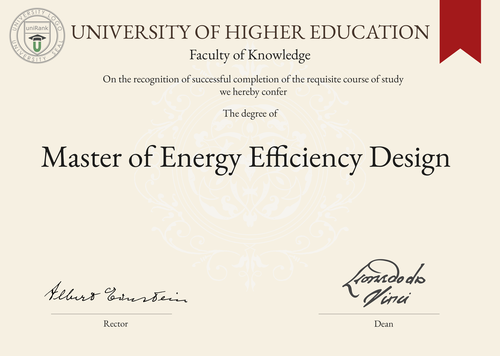
Master of Energy Efficiency Design (M.E.E.D.)
Guide to Master of Energy Efficiency Design Program/Course/Degree
Master of Energy Efficiency Design (M.E.E.D.)

Program Name:
Master of Energy Efficiency DesignProgram or Degree abbreviation:
M.E.E.D.Duration range:
The duration of the program typically ranges from 1 to 2 years.Tuition range:
The tuition fees for the program can vary depending on the chosen country or university. Please refer to the respective university's website for specific information.Overview:
The Master of Energy Efficiency Design program is designed to provide students with a comprehensive understanding of energy efficiency principles and practices. It equips students with the knowledge and skills necessary to develop sustainable energy solutions and promote energy-efficient design in various industries.Curriculum Overview by year:
- Year 1: Introduction to Energy Efficiency, Energy Management Systems, Sustainable Building Design, Renewable Energy Technologies. - Year 2: Advanced Energy Efficiency Strategies, Energy Policy and Economics, Energy Auditing and Analysis, Research Project.Key Components:
- Energy efficiency principles and practices - Sustainable building design - Renewable energy technologies - Energy management systems - Energy auditing and analysis - Energy policy and economicsCareer Prospects:
Graduates of the Master of Energy Efficiency Design program can pursue various career opportunities in both the public and private sectors. Potential job roles include energy consultant, sustainability manager, energy analyst, renewable energy project manager and energy efficiency engineer.Salary Expectations:
The salary expectations for individuals with a Master of Energy Efficiency Design degree can vary depending on factors such as location, industry and years of experience. On average, professionals in this field can expect competitive salaries. For a more accurate understanding of salary expectations, you can utilize the Job Sites Search Engine, from our sister site jobRank, which searches over 4,600 job sites worldwide. Make sure to specify not only the job title but also the country you are interested in.Conclusions:
It is important to note that the duration, tuition fees, curriculum, key components, career prospects and salary expectations of the Master of Energy Efficiency Design program can vary depending on the chosen country or location of study, as well as the university offering the program. Prospective students are advised to research and compare different universities and countries to find the best fit for their educational and career goals. Visitors can search for where this specific degree, the Master of Energy Efficiency Design, is offered anywhere in the world through the uniRank World Universities Search Engine.World Universities Search Engine
search for Master of Energy Efficiency Design (M.E.E.D.) and add the Location (country, state etc.) or specific University you are interested in studying at.
Query examples:
- Master of Energy Efficiency Design (M.E.E.D.) United States
- Master of Energy Efficiency Design (M.E.E.D.) United Kingdom online
- Master of Energy Efficiency Design (M.E.E.D.) Australia international students
- Master of Energy Efficiency Design (M.E.E.D.) University of California
- Master of Energy Efficiency Design (M.E.E.D.) University of London tuition fees
- Master of Energy Efficiency Design (M.E.E.D.) University of Sydney scholarships
Share Program/Course
Interesting? Share this program/course/degree info with your friends now.